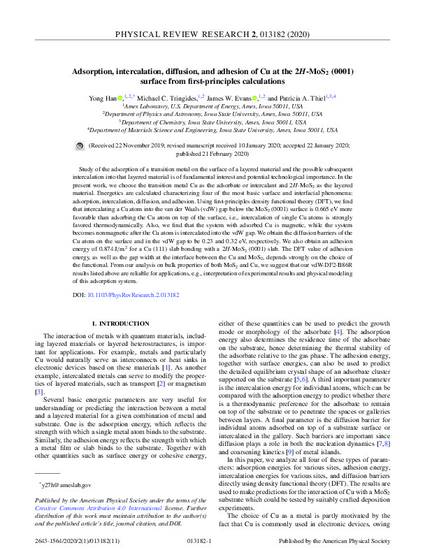
Study of the adsorption of a transition metal on the surface of a layered material and the possible subsequent intercalation into that layered material is of fundamental interest and potential technological importance. In the present work, we choose the transition metal Cu as the adsorbate or intercalant and 2H-MoS2 as the layered material. Energetics are calculated characterizing four of the most basic surface and interfacial phenomena: adsorption, intercalation, diffusion, and adhesion. Using first-principles density functional theory (DFT), we find that intercalating a Cu atom into the van der Waals (vdW) gap below the MoS2 (0001) surface is 0.665 eV more favorable than adsorbing the Cu atom on top of the surface, i.e., intercalation of single Cu atoms is strongly favored thermodynamically. Also, we find that the system with adsorbed Cu is magnetic, while the system becomes nonmagnetic after the Cu atom is intercalated into the vdW gap. We obtain the diffusion barriers of the Cu atom on the surface and in the vdW gap to be 0.23 and 0.32 eV, respectively. We also obtain an adhesion energy of 0.874 J/m2 for a Cu (111) slab bonding with a 2H-MoS2 (0001) slab. The DFT value of adhesion energy, as well as the gap width at the interface between the Cu and MoS2, depends strongly on the choice of the functional. From our analysis on bulk properties of both MoS2 and Cu, we suggest that our vdW-DF2-B86R results listed above are reliable for applications, e.g., interpretation of experimental results and physical modeling of this adsorption system.
Available at: http://works.bepress.com/patricia_thiel/179/

This article is published as Han, Yong, Michael C. Tringides, James W. Evans, and Patricia A. Thiel. "Adsorption, intercalation, diffusion, and adhesion of Cu at the 2H−MoS2 (0001) surface from first-principles calculations." Physical Review Research 2, no. 1 (2020): 013182. DOI: 10.1103/PhysRevResearch.2.013182. Posted with permission.